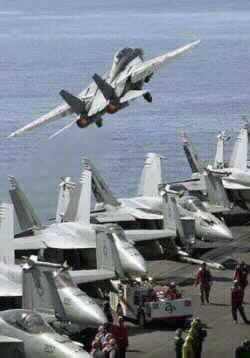- Author:
& News Agencies - Section:
WORLD HEADLINES
- Hajj & Umra WORLD HEADLINES
U.S., British Jets Bomb Southern Iraq 'No-Fly' Zone

U.S. and British warplanes bombed an air defense communications center in southern Iraq on Friday night after Iraqi forces fired artillery and missiles at the jets patrolling a "no-fly" zone in the south, the U.S. military said. Pentagon officials said Iraq has continued to try to shoot down the aircraft policing no-fly zones over northern and southern Iraq, even after Baghdad agreed last week to accept U.N. arms inspectors under a new Security Council resolution ordering the country to give up weapons programs.
The U.S. Central Command based in Tampa, Florida, said the jets attacked an air defense communications center near an-Najaf, about 85 miles southeast of Baghdad just before 11 p.m. in Iraq.
All aircraft left the area safely and damage to the ground target was being assessed, the command said.
"Today's strike came after Iraqi forces fired anti-aircraft artillery and surface-to-air missiles at coalition aircraft," the announcement said.
Defense Secretary Donald Rumsfeld suggested last week that if the Iraqis continued to fire at the warplanes, it would constitute a violation of the new U.N. resolution. But he was not specific on what that would mean, despite threats from President Bush to invade Iraq if President Saddam Hussein does not end nuclear, chemical and biological arms programs.
The number of incidents involving U.S. and British air patrols over no-fly zones in northern and southern Iraq has risen sharply in recent months as speculation has grown that the United States could launch an invasion to topple Saddam.
The warplanes have attacked Iraqi air defenses in the zones 57 times this year. Forty-four of those attacks have come in the southern zone.
Iraq does not recognize the zones, set up after the 1991 Gulf War to protect a Kurdish enclave in the north and Shi'ite Muslims in the south from attack by Saddam's military.
The most recent strike before Friday's was last Sunday, when American and British warplanes bombed anti-aircraft missile sites in the southern zone.
Those jets used precision-guided weapons to target two surface-to-air SAM missile sites near Tallil, approximately 175 miles southeast of Baghdad, according to the Central Command.
PHOTO CAPTION
An F-14D Tomcat takes off from the US Navy aircraft carrier USS Abraham Lincoln in the Gulf Monday, Nov.11, 2002. U.S. warplanes flying off an aircraft carrier struck targets in southern Iraq as they flew patrols over the no-fly zone on Sunday, Capt. Kendall L. Card, the commander of the USS Abraham Lincoln said Monday. (AP Photo/Amr Nabi
Related Articles
 Hajj virtues
Hajj virtues
-
School of Faith in Ten Days of Thul-Hijjah
The believing human self needs strong provocations in order to awaken whenever it is enveloped by laziness in...
-
The Status of Hajj in Islam
Hajj is the fifth pillar of Islam; Allah, The Exalted, ordained it in the ninth year after Hijrah (the Prophet's,...
-
School of Faith in Ten Days of Thul-Hijjah
The believing human self needs strong provocations in order to awaken whenever it is enveloped by laziness in relation...


 Home
Home Discover Islam
Discover Islam Quran Recitations
Quran Recitations Lectures
Lectures
 Fatwa
Fatwa Articles
Articles Fiqh
Fiqh E-Books
E-Books Boys & Girls
Boys & Girls  Hajj Rulings
Hajj Rulings Hajj Fatwas
Hajj Fatwas












